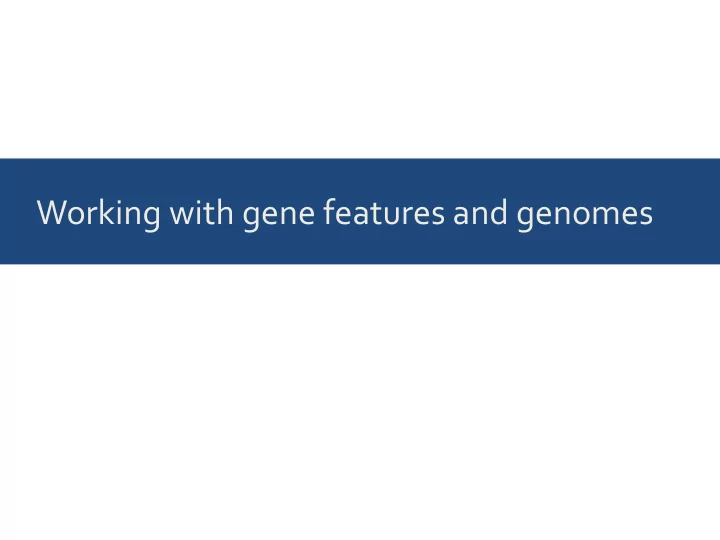

Working with gene features and genomes
Typical workflow when working with sequence data (e.g., genomes) 1. Download sequence data from NCBI 2. Save on local harddrive 3. Do analysis on locally stored sequence data 4. Repeat from step 3 – to fix bugs – to run a different analysis
We can do the initial download in Biopython # retrieve record from Entrez handle = Entrez.efetch(db="nucleotide", id="KT220438", rettype="gb", \ retmode="text") # read from the handle using regular Python, not SeqIO.read()! gb_file_contents = handle.read() handle.close() # the entire genbank file is now in the variable `gb_file_contents` print(gb_file_contents) LOCUS KT220438 1701 bp cRNA linear VRL 20-JUL-2015 DEFINITION Influenza A virus (A/NewJersey/NHRC_93219/2015(H3N2)) segment 4 hemagglutinin (HA) gene, complete cds. ACCESSION KT220438 VERSION KT220438.1 GI:887493048 KEYWORDS . SOURCE Influenza A virus (A/New Jersey/NHRC_93219/2015(H3N2)) ORGANISM Influenza A virus (A/New Jersey/NHRC_93219/2015(H3N2)) Viruses; ssRNA viruses; ssRNA negative-strand viruses; Orthomyxoviridae; Influenzavirus A. REFERENCE 1 (bases 1 to 1701)
We can do the initial download in Biopython # retrieve record from Entrez handle = Entrez.efetch(db="nucleotide", id="KT220438", rettype="gb", \ retmode="text") # read from the handle using regular Python, not SeqIO.read()! gb_file_contents = handle.read() handle.close() # write out to disk with open("KT220438.gb", "w") as out_handle: out_handle.write(gb_file_contents) # writes everything at once # now we can read back in and process with Biopython with open("KT220438.gb", "r") as in_handle: record = SeqIO.read(in_handle, format="gb") # use SeqIO to parse
Features in genbank files
FEATURES Location/Qualifiers source 1..1701 /organism="Influenza A virus (A/New Jersey/NHRC_93219/2015(H3N2))" /mol_type="viral cRNA" /strain="A/NewJersey/NHRC_93219/2015" /serotype="H3N2" /isolation_source="nasopharyngeal swab" /host="Homo sapiens" /db_xref="taxon:1682360" /segment="4" /lab_host="MDCK" /country="USA: New Jersey" /collection_date="17-Jan-2015" gene 1..1701 /gene="HA" CDS 1..1701 /gene="HA" /function="receptor binding and fusion protein" /codon_start=1 /product="hemagglutinin" /protein_id="AKQ43545.1" /db_xref="GI:887493049" /translation="MKTIIALSYILCLVFAQKIPGNDNSTATLCLGHHAVPNGTIVKT ITNDRIEVTNATELVQNSSIGEICDSPHQILDGENCTLIDALLGDPQCDGFQNKKWDL FVERSKAYSNCYPYDVPDYASLRSLVASSGTLEFNNESFNWTGVTQNGTSSACIRRSS SSFFSRLNWLTHLNYTYPALNVTMPNNEQFDKLYIWGVHHPGTDKDQIFLYAQSSGRI TVSTKRSQQAVIPNIGSRPRIRDIPSRISIYWTIVKPGDILLINSTGNLIAPRGYFKI RSGKSSIMRSDAPIGKCKSECITPNGSIPNDKPFQNVNRITYGACPRYVKHSTLKLAT GMRNVPEKQTRGIFGAIAGFIENGWEGMVDGWYGFRHQNSEGRGQAADLKSTQAAIDQ INGKLNRLIGKTNEKFHQIEKEFSEVEGRIQDLEKYVEDTKIDLWSYNAELLVALENQ
The source feature source 1..1701 /organism="Influenza A virus (A/New Jersey/NHRC_93219/2015(H3N2))" /mol_type="viral cRNA" /strain="A/NewJersey/NHRC_93219/2015" /serotype="H3N2" (...) • identifies the biological source of the specified span of the sequence; mandatory • more than one source key per sequence is allowed • every entry/record will have, as a minimum, either a single source key spanning the entire sequence or multiple source keys, which together, span the entire sequence
The gene feature gene 1..1701 /gene="HA" • region of biological interest identified as a gene and for which a name has been assigned
The CDS feature CDS 1..1701 /gene="HA" /function="receptor binding and fusion protein" /codon_start=1 /product="hemagglutinin" (...) • coding sequence • sequence of nucleotides that corresponds with the sequence of amino acids in a protein (location includes stop codon)
The mat_peptide feature mat_peptide 49..1035 /gene="HA" /product="HA1" • mature peptide or protein coding sequence • coding sequence for the mature or final peptide or protein product following post-translational modification • the location does not include the stop codon (unlike the corresponding CDS)
Influenza HA has one CDS but two mature peptides CDS 1..1701 /gene="HA" /function="receptor binding and fusion protein" /codon_start=1 /product="hemagglutinin" /protein_id="AKQ43545.1" (...) mat_peptide 49..1035 /gene="HA" /product="HA1" mat_peptide 1036..1698 /gene="HA" /product="HA2"
Many more feature types exist • centromere • exon • gap • LTR • mRNA • tRNA Full list with explanations at: http://www.insdc.org/files/feature_table.html#7.2
Working with features in Biopython
Features are stored as a list in Biopython genbank records In [1]: print(record.features) Out[1]: [SeqFeature(FeatureLocation(ExactPosition(0), ExactPosition(1701), strand=1), type='source'), SeqFeature(FeatureLocation(ExactPosition(0), ExactPosition(1701), strand=1), type='gene'), SeqFeature(FeatureLocation(ExactPosition(0), ExactPosition(1701), strand=1), type='CDS'), SeqFeature(FeatureLocation(ExactPosition(48), ExactPosition(1035), strand=1), type='mat_peptide'), SeqFeature(FeatureLocation(ExactPosition(1035), ExactPosition(1698), strand=1), type='mat_peptide')]
Features are stored as a list in Biopython genbank records In [1]: for feature in record.features: print(feature) Out[1]: type: source location: [0:1701](+) qualifiers: Key: collection_date, Value: ['17-Jan-2015'] Key: country, Value: ['USA: New Jersey'] Key: db_xref, Value: ['taxon:1682360'] (...) type: gene location: [0:1701](+) qualifiers: Key: gene, Value: ['HA'] type: CDS location: [0:1701](+) qualifiers: Key: codon_start, Value: ['1'] Key: db_xref, Value: ['GI:887493049']
Features have member variables type , location , and qualifiers In [1]: print("Type:", feature.type) print("\nLocation:", feature.location) print("\nQualifiers:", feature.qualifiers) Out[1]: Type: source Location: [0:1701](+) Qualifiers: {'organism': ['Influenza A virus (A/New Jersey/NHRC_93219/2015(H3N2))'], 'lab_host': ['MDCK'], 'strain': ['A/NewJersey/NHRC_93219/2015'], 'db_xref': ['taxon:1682360'], 'host': ['Homo sapiens'], 'segment': ['4'], 'isolation_source': ['nasopharyngeal swab'], 'collection_date': ['17-Jan-2015'], 'mol_type': ['viral cRNA'], 'serotype': ['H3N2'], 'country': ['USA: New Jersey']}
The qualifiers are stored as a dictionary In [1]: print(feature.qualifiers["organism"]) Out[1]: ['Influenza A virus (A/New Jersey/NHRC_93219/2015(H3N2))'] Note: The qualifiers dictionary returns a list! We need to extract the first element of the list if we want to just get the contents string. In [2]: organism = feature.qualifiers["organism"][0] print(organism) Out[2]: Influenza A virus (A/New Jersey/NHRC_93219/2015(H3N2))
Recommend
More recommend